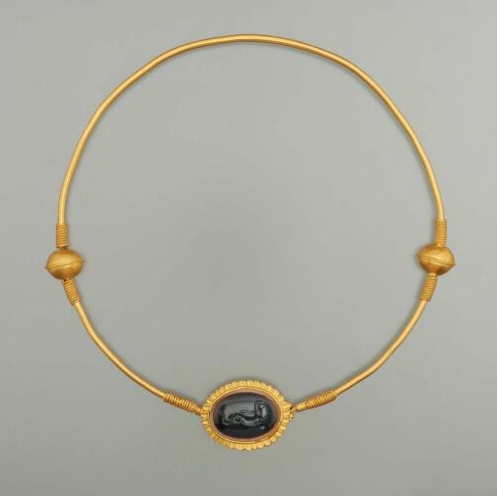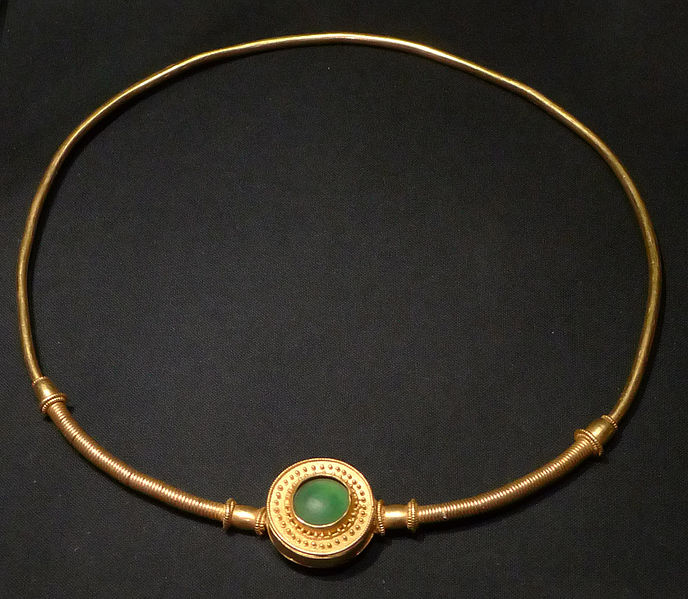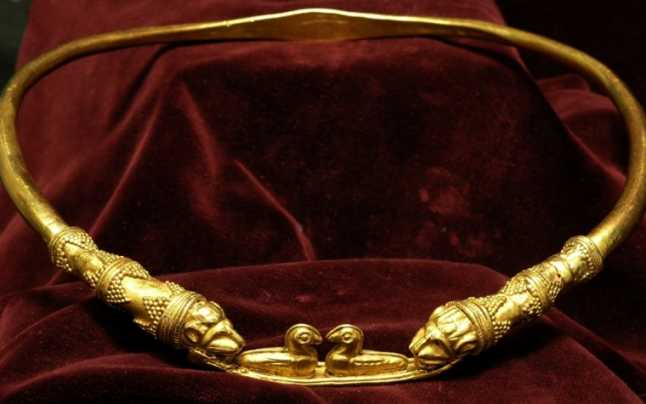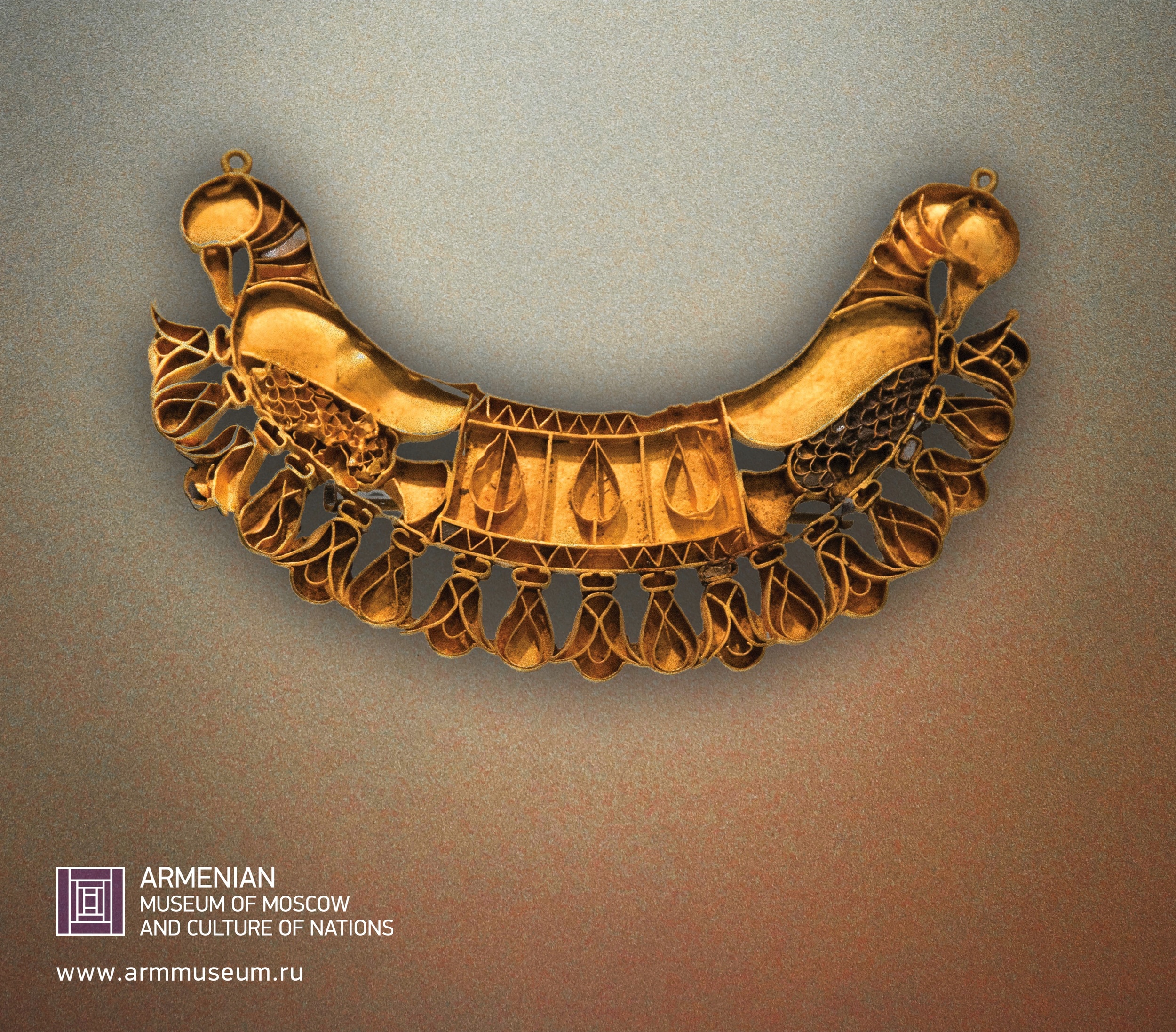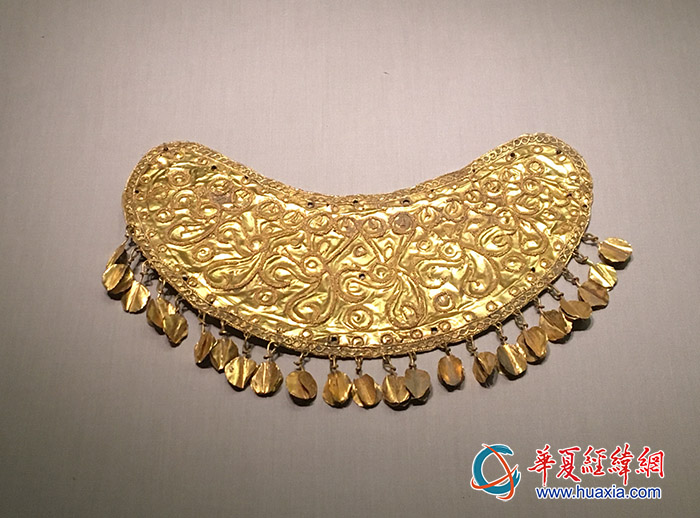
The gold treasure of Achterberg, The golden necklaces from Achterberg. photo Municipality of Rhenen (source https://www.gelderlander.nl/de-vallei/een-goudschat-voor-twee-dikke-winterjassen~a9e6c62f/)
This gold treasure, also known as the Rhenen gold treasure, consists of two gold necklaces (‘torques’ ) and a link of a necklace, and was found between 1930 and 1938.
In some settings of the gold link, the original filling of colored glass can be seen. They are decorated with golden balls. Classic acanthus motifs are applied to the ends of the link and on the back, probably made in a Roman workshop, although the link itself has a ‘barbarian’ shape. An inscription on the back tells that Ere made it for the gold weight of 5 unciae (136.44 grams) at a price of 22,000 denarii on behalf of Proclu(s), between 301 and 385. Source Vici.org

Maniakion – The Golden Torc in Late Roman and Early Byzantine Army, Zsolt Mráv https://www.researchgate.net/publication/282440071_Maniakion_-_The_Golden_Torc_in_Late_Roman_and_Early_Byzantine_Army
The 4th-century golden neckband with five inlaid precious stones of glass paste in the Centraal Museum, Utrecht (???) (after Roes 1947)

Mentioned >> 1. MY GRANDFATHER AND THE RHENENSE GOLD TREASURE Geerteke de Haas (black & white photo of the back side of the necklace) https://docplayer.nl/44901320-Bestuur-van-de-historische-vereniging-oudheidkamer-rhenen-en-omstreken.html
2. https://docplayer.nl/183050055-Eeuwige-rust-op-de-donderberg-een-groot-vroegmiddeleeuws-grafveld-bij-rhenen.html
3. A Late Roman gold neck ring with inscription from Walcheren (prov. Zeeland, NL) academia
ad. 1 ARTICLE https://www.oudrhenen.nl/ontstaan/goudschat/
The pieces were subjected to extensive examinations and their weights and measurements were determined. The largest neck ring weighs 85 grams and measures 23 by 20.9 cm. The smallest ring has a weight of 55 grams and a size of 22.5 by 12.7 cm. They are forged from extremely thin gold leaf. The decoration is stamped, a primitive way of decorating that gave a beautiful effect with little labor and little skill.
The experts all agreed that these rings are not really jewelry and that it is therefore not correct to talk about necklaces. Such braces are the forerunners of the mayor’s chain. They are between 375 and 400 AD. made from melted down Roman coins. At that time, the Roman Empire was already on its last legs and the emperors made an extreme effort to protect the western borders from the barbarian invasions. Germanic allies who took on the defense were rewarded with large sums of gold. The gold pieces functioned not so much as money. They were kept as treasure and then often melted down into neck rings, traditionally a sign of dignity.
In 1851, seven gold braces were found in Velp, six of which are very similar to the Rhenense. They have the same shape and decoration. They were probably made by the same maker, or at least from the same studio.
Comparison with other finds led to the conclusion that all these pieces must have been made in the east of our country or in West Germany near the Rhine. The link is a fragment of a larger whole, but the missing part has never been found. Given the length of this object, 17.8 cm, it must have been part of a necklace, it is too big for a bracelet. The stones on this piece of jewelry are surrounded by a pearl rim surrounded by a motif of acanthus leaves.
That motif is repeated on the back. There is also an inscription on the back. First, the letters EREF, which scientists who have attempted to interpret these letters say may indicate the maker’s initials. ERE would be the initials and the F is probably the abbreviation of Facit. That means: has made.
The weight and price are also indicated on this piece of jewelry and indicated at the same time. This makes the inscription particularly interesting for scientists. The letters EREF are followed by a horizontal line and the sign V. This indicates the weight and the price: literally it means unciae quinque. That corresponds to 136.44 grams. Without the stones, this piece of jewelry weighs 72 grams. It can be concluded from this that the remainder (missing) weighed 64.44 grams. The price corresponds to 22,000 denarii. The scientists converted that and concluded that one denarius was equal to 0.0062 grams of gold.
The last word on the back of the link is proclu(s). This is most likely the name of the first owner. The experts also concluded from the inscription that this piece of jewelry was made before the year 384.
This link is the rarest piece of the Rhenen gold treasure. Such specimens have only been found in Egypt and Switzerland. The gold braces are a little less rare. In addition to Velp, they have also been found in Nijmegen, Olst, Looveen (near Bellen) and Oestrich in Westphalia.
At the end of 1976 the find was copied by the Central Laboratory in Amsterdam. The copy was exhibited in Rhenen in the Streekmuseum and the original remained in Utrecht. Since 1991, the gold treasure has been returned to the Gemeentemuseum “Het Rondeel”.


5.27 | Two gold neckrings of Velp type and the lower part of Late-Roman gold necklace with stone settings from Rhenen-‘Achterberg’ (Utrecht). (coll. Museum Het Rondeel, Rhenen, photo O. Odé).
The splendour of power. Early medieval kingship and the use of gold and silver in the southern North Sea area (5th to 7th century); Johan Nicolay https://www.academia.edu
The jewelry hoard from Rhenen-‘ Achterberg’(Utrecht)
“In 1938, two gold neck rings and the central part of a gold necklace were found at Achterberg, a hamlet near Rhenen. They were said to be hidden at a depth of about 30 cm (fig. 5.27). Te complete torques, weighing 85 and 55 gr respectively, are decorated with lines of small dots and a variety of punch marks. Arm and neck rings with a similar shape and decoration, belonging to the Velp type, are known from five further sites in the eastern Nether-lands and adjoining Germany. Of the necklace only the central part, with a hinge at both ends, was found (weight 72 gr). This ‘exotic’ piece in late-Roman style is decorated with classical palmette motifs in relief, glass imitation gems (of which three are missing) and heavy, beaded gold wire. On the back, among a stamped palmette pattern, the following inscription can be read: ‘Ere (?) made this, at a weight of 5 unciae [136,44 g] and a value o 22.000denarii, by order of Proclus’.
Both hardly worn rings were produced in the late 4th or early 5th century, possibly in the Lower Rhine region.
The imported, late-Roman necklace is more heavily worn and was probably produced in the (second half of the) 4th century. For the set of jewelry a deposition date in the first half of the 5th century is most likely.”

